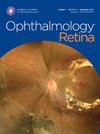Comparison of Blue-Light Autofluorescence and Ultrawidefield Green-Light Autofluorescence for Assessing Geographic Atrophy
IF 4.4
Q1 OPHTHALMOLOGY
引用次数: 0
Abstract
Purpose
The goal of this study was to evaluate and compare the intermodality and interreader agreement of manual and semiautomated geographic atrophy (GA) area measurements in eyes with GA due to age-related macular degeneration (AMD) using conventional blue-light fundus autofluorescence (FAF) and ultrawidefield (UWF) green-light FAF systems.
Design
Prospective Cohort Study.
Subjects
Seventy-two eyes of 50 patients with a diagnosis of advanced nonneovascular AMD with GA.
Methods
Fundus autofluorescence images of eyes with GA were obtained during a single visit using both the Spectralis HRA + OCT2 device and the Optos California device. The area of the GA lesion(s) was segmented and quantified (mm2) with a fully manual approach where the lesions were outlined using Optos Advance and Heidelberg Eye Explorer (HEYEX) software. In addition, for the Heidelberg blue FAF images, GA lesions were also measured using the instrument’s semiautomated software (Region Finder 2.6.4). For comparison between modalities/grading method, the mean values of the 2 graders were used. Intraclass correlation coefficients were computed to judge the agreement between graders.
Results
Seventy-two eyes of 50 patients were included in this study. There was nearly perfect agreement between graders for the measurement of GA area for all 3 modalities (intraclass correlation coefficient: 0.996 for manual Optos Advance, 0.996 for manual Heidelberg HEYEX, and 0.995 for Heidelberg Region Finder). The measurement of GA area was strongly correlated between modalities, with Spearman correlation coefficients of 0.985 (P < 0.001) between manual Heidelberg and manual Optos, 0.991 (P < 0.001) for Region Finder versus manual Heidelberg, and 0.985 (P < 0.001) for Region Finder versus manual Optos. The absolute mean area differences between the Heidelberg manual versus Region Finder, manual Optos versus Region Finder, and manual Optos versus manual Heidelberg were 1.61 mm2 (P < 0.001), 0.90 mm2 (P < 0.006), and 0.71 mm2 (P < 0.001), respectively.
Conclusions
We observed excellent interreader agreement for measurement of GA using either 30-degree blue-light FAF or UWF green-light FAF, establishing the reliability of UWF imaging for macular GA assessment. Although the absolute measurements between devices were strongly correlated, they differed significantly, highlighting the importance of using the same device for a given patient for the duration of a study.
Financial Disclosure(s)
Proprietary or commercial disclosure may be found in the Footnotes and Disclosures at the end of this article.
蓝光自发荧光与超宽场绿光自发荧光在评估地理萎缩方面的比较
目的:本研究旨在评估和比较使用传统蓝光和超宽场(UWF)绿光眼底自动荧光(FAF)系统对因年龄相关性黄斑变性(AMD)引起的GA(地理萎缩)眼进行手动和半自动GA(地理萎缩)面积测量的模式间和读片者间一致性:方法:使用 Spectralis HRA+OCT2 设备和 Optos California 设备,在单次就诊时获取患有 GA 的眼睛的 FAF 图像。导出图像后,由两名独立的遮盖分级人员进行遮盖分析。用全手工方法分割和量化 GA 病变的面积(平方毫米),用 Optos Advance 和 Heidelberg Eye Explorer (HEYEX) 软件勾勒出病变的轮廓。此外,对于海德堡蓝光 FAF 图像,也使用仪器的半自动软件(Region Finder 2.6.4)测量 GA 病变。为了比较不同模式/分级方法,使用了两个分级者的平均值。计算类内相关系数(ICC)来判断分级者之间的一致性:本研究共纳入 50 名患者的 72 只眼睛。在所有三种模式下,分级者之间对GA面积的测量几乎完全一致(手动Optos Advance的类内相关系数=0.996,手动海德堡HEYEX的类内相关系数=0.996,海德堡Region Finder的类内相关系数=0.995)。GA面积的测量在不同模式之间具有很强的相关性,手动海德堡与手动Optos的斯皮尔曼相关系数为0.985(p < 0.001),区域查找器与手动海德堡的相关系数为0.991(p < 0.001),区域查找器与手动Optos的相关系数为0.985(p < 0.001)。海德堡手动与区域定位仪、手动 Optos 与区域定位仪、手动 Optos 与手动海德堡之间的绝对平均面积差异为 1.61 平方毫米(p2):我们观察到,无论是使用 30 度蓝色 FAF 还是 UWF 绿色 FAF 测量 GA,读片者之间的一致性都非常好,这证明了 UWF 成像用于黄斑 GA 评估的可靠性。虽然不同设备之间的绝对测量值有很强的相关性,但它们之间的差异很大,这突出了在研究期间对特定患者使用同一设备的重要性。
本文章由计算机程序翻译,如有差异,请以英文原文为准。
求助全文
约1分钟内获得全文
求助全文

 求助内容:
求助内容: 应助结果提醒方式:
应助结果提醒方式:


